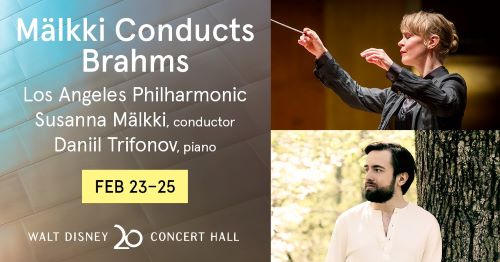A NIGHT OF ELEGANCE AND VIRTUOSITY
The February 23, 2024 Los Angeles Philharmonic concert at the Walt Disney Hall was an opportunity to see two renowned classical musicians, conductor Susana Mälkki and pianist Daniil Trifonov.
Witnessing Mälkki’s conducting is a captivating experience. Her technique is characterized by swift arm movements that allow her to maintain precise timing, especially evident when she employs large, sweeping gestures with a long baton. This clarity and speed make it easy and enjoyable for the audience to follow along. Mälkki adds an elegant, ballet-like quality to her conducting, with her legs occasionally bending or even lifting off the ground to embody the music’s essence, while her upper body moves with the grace of a dancer. Mälkki’s meticulous attention to detail and profound understanding of musical scores enable her to masterfully balance the intricate interactions among different sections of the orchestra.
The short Academic Festival Overture, initiating the concert, serves as a vibrant showcase of Johannes Brahms’s skill in orchestration and his keen sense of humor. Crafted in 1880 as an expression of gratitude to the University of Breslau (present-day Wroclaw, Poland) for awarding him an honorary doctorate, this piece encapsulates the jubilant spirit of academic celebrations and showcases Brahms’ distinctive musical style.
The overture opened with a grand orchestral proclamation, immediately captivating the audience with its bold brass fanfare. Brahms’s richly textured orchestrations and harmonies then unfolded, skillfully interlaced with snippets of student tunes and traditional German drinking songs. The piece progressed through a series of striking contrasts, oscillating between exuberant, lively segments and moments of deep reflection. Under Mälkki’s dynamic leadership, Brahms’s catchy melodies were infused with vigor, culminating in enthusiastic applause for her vibrant conducting.
Brahms humorously referred to his second Piano Concerto, the final work in the evening’s program, as a “tiny, tiny piano concerto with a tiny, tiny wisp of a scherzo” when it really stands as the most substantial and lengthy piano concerto in the standard repertoire. Far from being small, the concerto is famously challenging, featuring complex elements like broad chords, intricate arpeggios, demanding trills, and various other technical hurdles. Despite these difficulties, the interaction between the piano and orchestra is designed to be balanced, ensuring that the demanding piano segments are not just for show but are integral to the musical experience. This aspect might make the piece feel less gratifying despite its virtuosity. Yet, for pianists who possess the necessary endurance and expertise, tackling this concerto is akin to climbing a musical Mount Everest, maintaining its status as a hallmark of performance excellence.
Daniil Trifonov, a Russian pianist distinguished by his shoulder-length hair and beard, giving him the appearance of a mystical prophet, stands among the foremost pianists of our time. His performance of Brahms’s monumental concerto did not disappoint.
The first movement, Allegro non Troppo (Fast but not overly so) has a famously evocative opening, the principal horn (beautifully played by David Cooper) presented the first sounds of the movement’s main theme. Trifonov on the piano seamlessly picked up the musical conversation as a soloist, leading into extended, triumphant piano solos interchanged with the orchestra. What stood out was Trifonov’s ability to sustain the expansive lines of the movement, maintaining a coherent narrative amidst the complexity of Brahms’s musical ideas. The cadenza was a highlight, showcasing Trifonov’s virtuosity and emotional depth, while seamlessly integrating with the thematic material of the movement. Under Mälkki’s direction, the LA Phil harmonized dynamic shifts from the podium, meshing seamlessly with the nuanced exchange between pianist and orchestra.
The second movement is marked Allegro Appassionato (passionately brisk) and is a mostly tumultuous movement. Trifonov delved into the passionate and stormy character of the music with full force, his fingers traversing the keyboard with agility and precision. The contrasts between the tumultuous and more lyrical sections were handled with great finesse. Trifonov’s dynamic control was remarkable, moving from thunderous climaxes to moments of tender intimacy without losing the thread of the movement’s forward momentum. The orchestra beautifully harmonized with the piano creating a lush wall of sound.
The third movement, marked Andante (Slow), is where the heart of Brahms’ concerto lies. This movement stands out for its unique incorporation of an extensive cello solo within the framework of a piano concerto. Robert DeMaine, exquisite on Cello, played the theme for the first three minutes before the piano came in. Trifonov navigated the movement’s emotional landscapes with a moving sensitivity and depth. His touch on the piano was at once gentle and decisive, allowing the melody to unfold with a clarity and warmth that seemed to embrace the listener. The orchestra provided a lush, responsive backdrop to Trifonov’s playing. The strings were particularly notable for their velvety tone, weaving in and out of the piano’s narrative with grace and precision. The woodwinds added layers of texture and conversation, echoing the piano’s themes and expanding on them with their own voices.
The concerto culminated with the fourth movement, marked Allegretto grazioso (fairly fast, graciously), bursting forth with a spirited Hungarian folk-dance motif. The finale showcased Trifonov’s dazzling technical prowess, as the piano and orchestra engaged in a thrilling exchange of themes, culminating in a triumphant finale that had the audience jumping to their feet.
For his one encore, Trifonov played the Chopin Cello Sonata with Robert DeMaine on the cello. It was short but beautiful and left this reviewer wishing for more encores.
Unlike some of his contemporaries, such as Yuja Wang and Lang Lang, Trifonov isn’t heavily hyped by his publicity team. Trifonov’s effortless gimmick-free technique, however, solidifies his position as one of the greatest living pianists. The combination of Mälkki, Trifonov and the best-in-class Los Angeles Philharmonic made this a night to remember.
[Editor’s Note: The reviewed performance, Feb 23, had an abbreviated program different from Feb 24 & 25. Included on the latter two programs was the U.S. premiere of Enno Poppe’s Fett, an LA Phil commission.]

